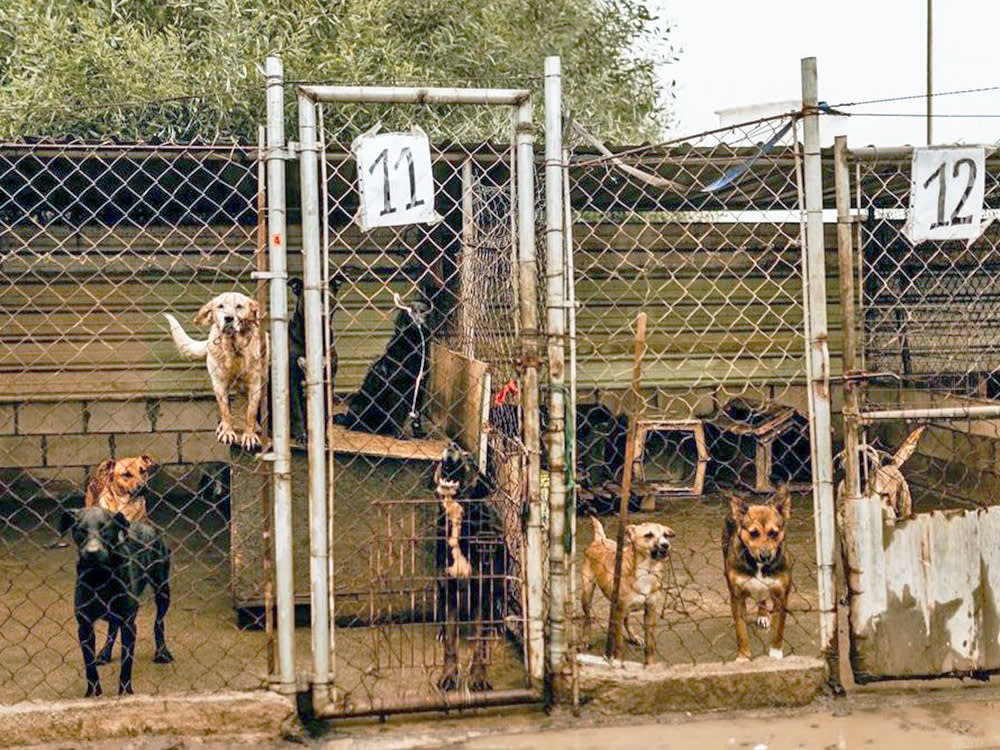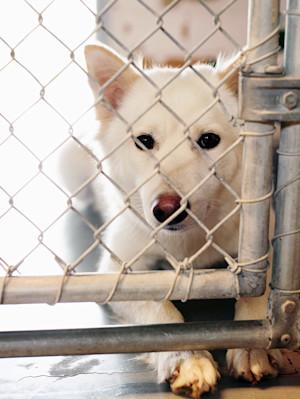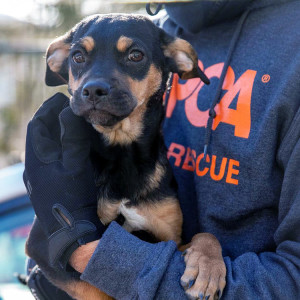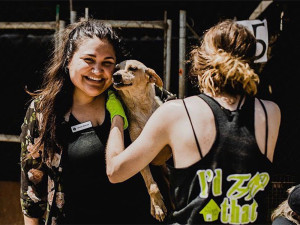The Hard Truth: Some So-Called “Rescues” Are Hoarding Situations in Disguise
Here’s how to recognize the signs that you’ve encountered one.

Share Article
In February, 90 dogs were removed from a propertyopens in new tab in Vernon Township, New Jersey. The owners claimed it was a “nonprofit, no-kill rescue,” but in reality the dogs were not cared for — they were sick, injured, and some were dead. In September 2023, after months of reports from local activists, a woman in Chandler, Arizona was arrested on 55 counts of animal abuse and 55 counts of animal cruelty.
She ran a supposed “special needs rescue,” but the truth was the dogs were being kept in horrible conditions, stacked in crates in a 900-square-foot home. In June 2023, 400 dogs were pulled from a so-called rescue opens in new tab in Ensenada, Mexico; the rescue raised funds for the dogs, many of whom were in urgent need of medical care, on social media. The owner pocketed the money, and the dogs never received care.
Hoarding situations masquerading as animal rescues are disturbing, heartbreaking, and unfortunately not uncommon. We spoke with Lauren Botticelli, executive director of The Animal Padopens in new tab, who assisted in several recent hoarding rescues, and Beth Brandler, legal advocacy senior counsel at the ASPCA, to help explain why and how these situations happen — and what you can do to help.
When does a rescue become a hoarding situation?
Beth Brandler tells us that animal hoarding can be identified when an individual or organization is sheltering an excessive number of animals beyond their capacity to provide proper and suitable care. Not all rescue hoarding situations begin with malicious intent; sometimes, they come about when rescues simply take in more animals than they adopt out.
How much do you spend on your pet per year?

“Over time, the number of animals increases and surpasses the capacity of the rescue to provide sufficient care, leading to deteriorating living conditions, a lack of necessary veterinary care, and a poor quality of life for the animals,” Brandler says.
How do these so-called rescues acquire so many animals?
“Generally, rescues acquire their animals by pulling them from local shelters and by accepting surrendered animals from members of the community,” Brandler says. Animals are also sometimes dropped off anonymously, with the hope that they’ll be provided care, without the rescue’s permission. Animals not being spayed or neutered can also add to the rescue’s population.
But it’s one thing when a legitimate rescue’s population gets out of control; it’s another when cruelty is baked into the idea of the operation. How do those people or organizations, who are not operating legitimately, acquire the amount of animals they end up having control over? “The way these people acquire dogs is by fooling everybody into thinking they’re legitimate,” Botticelli adds.
The organizations’ owners are typically skilled in manipulation, and know how to evade suspicion. Botticelli used April McLaughlin, who ran the fake special-needs rescue in Chandler, Arizona and has operated under several aliases, as an example. “She was taking [special needs] dogs from other rescues that thought they were doing the right thing by sending them to a specialized rescue who could do more for them,” she said. “And ultimately, it was the complete opposite.”
The rescues who sent their dogs to McLaughlin thought they were doing their due diligence. Her so-called special needs rescue was a 501(c)(3), a legitimate organization on paper, and she underwent home checks before any animal was sent to her. The trouble was, almost all of the rescues were out of state, some all the way across the country, and they conducted the home checks via video call. For these calls, McLaughlin would rent Airbnbs and pass them off as her home. “It was wild, the lengths that she went to to be able to acquire these animals,” Botticelli says.
What are the motivations behind those who run animal rescues that are actually hoarding?
Botticelli is careful to note that not all hoarding cases happen intentionally or out of malice. Sometimes families who love their dogs haven’t kept up on spay and neuter, resulting in multiple unplanned litters, or have simply taken in too many dogs whose needs they can’t address alone. Ideally, the people who accidentally become overwhelmed, or who can’t afford to spay and neuter, seek out and accept help so the animals in their care are not subject to harm. (“We’ll always help people when they come to us,” Botticelli says.)
Brandler also stresses that we should not jump to conclusions about a person’s intentions. “Animal hoarding is a complex issue that often encompasses mental health, animal welfare, and public safety concerns,” she says. “Given the complexities of mental health and variation between situations, each case is unique and must be treated as such.” When there is a large number of animals living with dangerously inadequate care, and when their human is unwilling to accept help, Brandler says a multi-faceted intervention is necessary to ensure both the person and the animals get the help they need.
But cases of hoarding masquerading as rescues can be much more strategic. McLaughlin worked hard to hide her criminal misconduct. And so did the owner of the “rescue” in Ensenada, Mexico, where the Animal Pad assisted in saving nearly 400 dogs.
“They were hoarding animals and posting about their medical needs to get donations, and then were not getting medical care for the dogs at all,” Botticelli says. “It was a ton of dogs who were medically super fragile and sick and not well.” Many of them were just left to die, while the donations — made by people thinking they were donating specifically to the dogs’ care — were used, as Botticelli says, “for God knows what.”
How do hoarding cases affect local shelters and rescues?
After the Animal Pad helped to rescue the animals from the Ensenada hoarding case, they were immediately met with another problem — what to do with 400 dogs, all at once, who were in need of medical care and a place to stay.
“We were reaching out for anybody, any rescue that could take in a small handful of these dogs,” Botticelli says. “And we did have probably about 20 rescues that stepped up to take in a small number each; that was about 100 dogs in total, and then we were responsible for the other 300.” They’ve since placed all but about 100 dogs, who are waiting for placement in a safe facility in Mexico.
The Arizona case was a bit different — because the 55 animals rescued were part of an open court case, they had to spend at least a month at the Arizona Humane Society. “That put a huge stress on the staff,” Botticelli says, particularly because all of the animals had special needs. “Even though they did a great job, it was definitely something that took a toll on their staff, as people who probably are not used to that level of animal care.”
“With the removal of animals from a hoarding situation, the burden on local shelters to manage the care and placement of the animals can be staggering,” Brandler says. The ASPCA Cruelty Recovery Center (CRC) is a permanent facility dedicated to helping vulnerable animals, like those rescued from large-scale cruelty situations like hoarding. If you know a local shelter or rescueopens in new tab has recently taken in a large number of animals from a hoarding case, Brandler says, volunteer your time to help them — this can mean washing cages, walking animals, or socializing them; anything you can do to help lighten their load.
How can you identify hoarding situations? And what should you do if you think you know of one?
While having multiple animals does not automatically indicate hoarding, Brandler says there are things to look out for if you’re suspicious that someone has an unmanageable problem. If the number of animals seems unusual; if minimal standards of nutrition, sanitation, shelter, and veterinary care are not provided; if the property has deteriorated; if windows have been covered to prevent anyone from seeing inside; if you notice a strong odor, or fleas and vermin; and if animals are emaciated, lethargic, and under-socialized.
If you think you’ve identified a hoarding situation, Brandler says phone calls are your first step. “Many communities now have Hoarding Task Forces with representatives from code enforcement, mental health, social services, and animal care and control experienced in working collaboratively to respond to hoarding situations,” she says. If a Hoarding Task Force isn’t available in your area, she suggests calling your local humane law enforcement department, police department, or animal welfare organization; you might also phone local social service groups who can provide assistance.
It can also help to reassure the person that it is okay to accept help. “People who accumulate animals may be worried that their animals will be killed, or that they will never see them again,” Brandler says. “Assure them that the animals need urgent care, and that immediate action is necessary.”
Botticelli echoes that you should reach out to your local humane law enforcement agency if you suspect someone is hoarding animals, or running a counterfeit rescue organization. “Here in San Diego, it’s the Humane Society of San Diegoopens in new tab,” she says. There, you can report any kind of crime or cruelty against animals. “If you contact them and report something — and you can do it anonymously — they’ll go out do an investigation.”
Botticelli says the Animal Pad sometimes gets reports of animal cruelty, which they then also have to take to their humane law enforcement agency. “We don’t have jurisdiction to just go out and confiscate animals as a rescue group, at all,” she says. “So, we have to go through the proper channels as well.” If the agency deems a situation unsafe or unfit, they then reach out to rescue group to help take on the animals and get them the shelter and care they need. “And so if anyone is under suspicion that there might be something going on,” she says, “calling and doing an anonymous report is always something that I suggest.”

Kelly Conaboy
Kelly Conaboy is a writer and author whose work has been featured in New York Magazine, The New York Times, and The Atlantic. Her first book, The Particulars of Peter, is about her very particular dog, Peter. (Peter works primarily as a poet.)
Related articles
![Girl sitting on couch hugging her playful dog with the window open to outside]()
7 Myths About Rescue Animals—Debunked
For starters: No, they’re not all traumatized and yes, you can find a purebred puppy at a shelter.
![A dog at a shelter looking up at the camera.]()
10 Questions to Ask a Shelter About an Adoptable Dog
From exercise needs to medical history to compatibility with kids, here is everything you need to know.
![A hand reaching towards a cat peaking out of a cage.]()
10 Questions to Ask a Shelter About an Adoptable Cat
From medical history to adoption fees to litter preferences, here is everything you need to know.
![Happy Labrador Retriever sitting on the floor]()
Did You Know 25% of Shelter Dogs Are Purebred?
If your heart is set on a purebred pup, start your search at breed-specific rescue organizations.
![anonymous woman pampering and taking care about a small ginger kitten]()
6 Ways to Help Local Shelters Without Committing to Full-Time Pet Parenthood
Learn how you can be there for animals in need this National Pet Day.
![Couple hug their Pit Bull dog outside on the beach.]()
How to Help the Rescue Pets Who Seem to Be Stuck at Shelters Forever
And why the problem of long-term rescue and foster animals persists.









